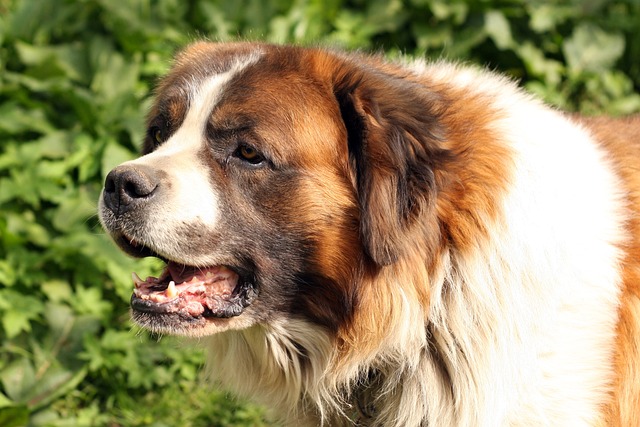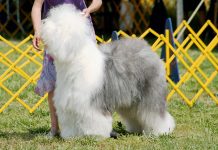History and Origins of the St. Bernard Breed

The St. Bernard is a noble and iconic breed with a rich history. Here’s an overview of its origins:
- Monastery Dogs: The St. Bernard breed originated in the Swiss Alps, specifically at the Great St. Bernard Hospice, a hospice and monastery founded in the 11th century. The monks kept large dogs for companionship and as working dogs to assist in their mountain rescue operations.
- Early Breeding Purpose: St. Bernards were originally bred for rescue work in the treacherous Alpine passes. They were trained to locate lost or injured travelers in the snow and to provide warmth and companionship until help arrived.
- Breed Development: Over time, the St. Bernard breed was selectively bred for its size, strength, endurance, and gentle temperament. These qualities made them ideal for their rescue duties in harsh mountain conditions.
- Barry the Hero: One of the most famous St. Bernards was Barry, who reportedly saved over 40 lives during his time at the hospice in the early 1800s. His heroic deeds contributed to the breed’s legendary status.
- Recognition and Popularity: St. Bernards gained international recognition and popularity in the 19th century after stories of their rescue efforts spread across Europe. They were brought to England and other countries, where they became beloved companions and show dogs.
Physical Characteristics and Appearance of St. Bernards
St. Bernards are large, powerful dogs with distinctive physical features. Here are the key characteristics of the breed:
- Size: St. Bernards are among the largest dog breeds, with males typically standing 27 to 30 inches (68 to 76 cm) tall at the shoulder and weighing between 140 to 180 pounds (63 to 81 kg). Females are slightly smaller but still substantial in size.
- Build: St. Bernards have a strong and muscular build, with a deep chest and broad shoulders. They are well-balanced and sturdy, reflecting their heritage as working dogs.
- Coat: The breed has a dense and weather-resistant double coat that can be either short or long. The outer coat is smooth and may be slightly rough, while the undercoat is thick and insulating.
- Color: St. Bernards typically have a white base coat with patches of red, mahogany, brindle, or tan on the body, ears, and face. The classic “splash” pattern is well-known, with darker markings over the eyes and ears, on the sides of the neck, and on the body.
- Head: St. Bernards have a large and impressive head with a slightly wrinkled forehead. The muzzle is broad and deep, with a well-defined stop.
- Eyes: The breed’s eyes are medium-sized, dark brown in color, and convey a gentle and intelligent expression.
- Ears: St. Bernards have medium-sized, triangular ears that hang close to the head.
- Tail: The tail is long and broad at the base, tapering towards the tip. It is carried low and may have a slight upward curve.
- Expression: St. Bernards are known for their kind and gentle expression, which reflects their friendly and affectionate temperament.
- Gait: Despite their size, St. Bernards move gracefully and with purpose. Their movement is powerful yet steady, reflecting their strength and agility.
St. Bernards are beloved for their gentle nature, loyalty, and impressive appearance. They make excellent family companions and are known for their patience and affection towards children. However, due to their size, they require proper training, socialization, and regular exercise to thrive as well-rounded pets.
St. Bernard Temperament and Personality Traits
St. Bernards are known for their gentle and friendly temperament, making them wonderful family companions. Here are the key temperament and personality traits of the breed:
- Gentle Giants: St. Bernards are affectionate and gentle giants, known for their calm and patient demeanor. They are typically excellent with children and make wonderful family pets.
- Friendly and Sociable: St. Bernards are friendly and sociable dogs that enjoy the company of people and other animals. They thrive on companionship and are not prone to aggression.
- Loyal and Devoted: St. Bernards are deeply loyal to their families and form strong bonds with their owners. They are protective when needed but are not aggressive guard dogs.
- Easygoing and Mellow: Despite their large size, St. Bernards have a mellow and easygoing nature. They are not overly energetic or hyperactive but enjoy lounging and relaxing with their family.
- Patient and Tolerant: St. Bernards are known for their patience and tolerance, especially with children. They can handle the rough play and antics of kids with grace and gentleness.
- Watchful and Alert: While St. Bernards are not overly vocal, they are watchful and alert to their surroundings. They make excellent watchdogs due to their size and deep bark.
- Intelligent but Independent: St. Bernards are intelligent dogs but can be independent thinkers. They respond well to training but may have a stubborn streak and require patient, consistent training methods.
- Affectionate and Cuddly: St. Bernards are affectionate dogs that enjoy cuddling and being close to their family members. They often seek out physical contact and enjoy being part of the family activities.
- Moderate Energy Level: Despite their large size, St. Bernards have a moderate energy level. They require regular exercise to stay healthy and prevent obesity but are not overly demanding in terms of activity.
- Adaptable: St. Bernards can adapt well to different living situations, including apartments, as long as they have enough space to move around comfortably. They prefer indoor living and thrive in a climate-controlled environment.
Training and Exercise Needs for St. Bernards
St. Bernards benefit from consistent training and regular exercise to keep them physically and mentally stimulated. Here’s how to meet their training and exercise needs:
- Early Socialization: Start socializing your St. Bernard puppy early to expose them to different people, animals, and environments. This helps them develop into well-rounded and confident adults.
- Obedience Training: St. Bernards are intelligent but can be stubborn, so start obedience training early and be patient and consistent with your commands. Use positive reinforcement techniques such as treats and praise.
- Gentle Handling: Due to their large size, St. Bernards require gentle handling and positive interactions during training. Avoid harsh training methods or physical corrections.
- Regular Exercise: While not overly active, St. Bernards benefit from regular exercise to maintain a healthy weight and prevent boredom. Daily walks, play sessions, and moderate activities such as hiking are suitable.
- Avoid Overexertion: Be mindful of your St. Bernard’s size and avoid overexertion, especially in hot weather. Monitor them closely during exercise and provide plenty of breaks and water.
- Training for Leash Manners: St. Bernards can be strong pullers due to their size. Train them to walk politely on a leash and use a sturdy harness to prevent neck strain.
- Consistent Routine: Establish a consistent daily routine for feeding, exercise, and training. St. Bernards thrive on predictability and structure.
- Positive Reinforcement: Use positive reinforcement techniques such as treats, praise, and playtime to motivate your St. Bernard during training sessions. Keep training sessions short and engaging.
- Mental Stimulation: In addition to physical exercise, provide mental stimulation for your St. Bernard through interactive toys, puzzle games, and training exercises that challenge their problem-solving skills.
- Patience and Consistency: Training a St. Bernard requires patience, consistency, and positive reinforcement. Stay calm and patient throughout the training process to build a strong bond with your gentle giant.
By providing early socialization, consistent training, and regular exercise, you can help your St. Bernard develop into a well-mannered, happy, and healthy companion. Be mindful of their gentle nature and adapt your training approach accordingly to bring out the best in this lovable breed.
Health Considerations and Common Issues in St. Bernards
St. Bernards are generally healthy dogs, but like all breeds, they can be prone to certain health issues. It’s important for St. Bernard owners to be aware of potential health concerns and take preventive measures. Here are common health considerations for St. Bernards:
- Gastric Dilatation-Volvulus (GDV): Also known as bloat, GDV is a life-threatening condition where the stomach fills with gas and twists. This can be caused by eating too quickly, exercising after eating, or other factors. Immediate veterinary attention is required if bloat is suspected.
- Hip Dysplasia: This is a common orthopedic condition where the hip joint doesn’t develop properly, leading to arthritis and mobility issues. St. Bernards are prone to hip dysplasia due to their size. Regular veterinary check-ups and screening can help manage this condition.
- Elbow Dysplasia: Similar to hip dysplasia, elbow dysplasia affects the elbow joint and can cause lameness, pain, and arthritis. X-rays and orthopedic evaluations can detect elbow dysplasia early.
- Osteosarcoma: St. Bernards are at higher risk for osteosarcoma, a type of bone cancer. Early detection and treatment are crucial for managing this aggressive disease.
- Eye Problems: St. Bernards can be prone to eye issues such as entropion (eyelid rolling inward), ectropion (eyelid rolling outward), cataracts, and cherry eye. Regular eye exams by a veterinary ophthalmologist are recommended.
- Heart Conditions: Dilated cardiomyopathy (enlarged heart) and subaortic stenosis (narrowing of the heart’s outflow tract) are cardiac issues that can affect St. Bernards. Annual cardiac evaluations are important for early detection and management.
- Hypothyroidism: St. Bernards may develop hypothyroidism, a condition where the thyroid gland doesn’t produce enough hormones. Symptoms include weight gain, lethargy, and skin problems. Treatment involves hormone replacement therapy.
- Heat Sensitivity: Due to their thick coat and large size, St. Bernards are sensitive to heat and can easily overheat. They should be kept cool and hydrated, especially in hot weather.
- Obesity: St. Bernards are prone to obesity, which can exacerbate joint issues and other health problems. A balanced diet and regular exercise are important for maintaining a healthy weight.
- Ear Infections: St. Bernards with floppy ears are prone to ear infections. Regular ear cleaning and inspections can help prevent infections.
Living with a St. Bernard: Suitable Environments and Lifestyle Considerations

St. Bernards are gentle giants that thrive in certain environments and lifestyles. Here are considerations for living with a St. Bernard:
- Space: St. Bernards require ample space due to their large size. They are best suited to homes with a fenced yard where they can move around comfortably. However, they can adapt to apartment living if provided with regular exercise and mental stimulation.
- Climate: St. Bernards are sensitive to heat due to their thick coat. They are best suited to cooler climates and should have access to shade and cool water during hot weather.
- Exercise Needs: Despite their mellow nature, St. Bernards require regular exercise to stay healthy and prevent obesity. Daily walks, play sessions, and moderate activities are recommended.
- Grooming: St. Bernards have a dense double coat that requires regular grooming to prevent matting and tangles. Brush their coat several times a week and bathe them as needed.
- Training and Socialization: Early training and socialization are crucial for St. Bernards to develop good manners and confidence. They respond well to positive reinforcement techniques.
- Health Monitoring: Schedule regular veterinary check-ups, vaccinations, and preventive care to monitor your St. Bernard’s health and detect any potential issues early.
- Family Interaction: St. Bernards are affectionate and enjoy being part of the family. They are excellent with children but should be supervised due to their size.
- Safety Precautions: Due to their size and strength, St. Bernards should be taught proper leash manners and supervised around small children and other pets. Use a sturdy harness for walks.
- Comfortable Living Environment: Provide a comfortable and climate-controlled living environment for your St. Bernard, with access to soft bedding and indoor areas.
- Nutrition: Feed your St. Bernard a high-quality diet appropriate for their age, size, and activity level. Avoid overfeeding to prevent obesity.
By understanding the health considerations and lifestyle needs of St. Bernards, you can provide them with a safe, comfortable, and fulfilling life. Proper care, regular veterinary attention, and a loving environment will help ensure that your St. Bernard remains happy and healthy for years to come.
St. Bernard Variations and Breeding Practices
St. Bernard Variations and Breeding Practices
St. Bernards are a distinctive breed with variations in appearance and coat types. Responsible breeding practices are essential for maintaining the health, temperament, and breed standards of St. Bernards. Here’s an overview of variations and breeding practices:
Variations in St. Bernards:
- Coat Type: St. Bernards can have either a short coat or a long coat. The short-coated variety has a dense, smooth, and slightly rough outer coat with a thick undercoat. The long-coated variety has a silky and slightly wavy coat with feathering on the legs and tail.
- Coloration: St. Bernards typically have a white base coat with patches of red, mahogany, brindle, or tan. The classic “splash” markings are well-known, with darker patches over the eyes, ears, and body.
- Size: While St. Bernards are generally large dogs, there can be variations in size within the breed. Some St. Bernards may be slightly smaller or larger than the average standard, but breeders aim to maintain a consistent size range.
Breeding Practices for St. Bernards:
- Health Screening: Ethical breeders conduct thorough health screenings on their breeding stock to identify and eliminate genetic health issues. Common health screenings for St. Bernards include hip and elbow dysplasia, cardiac evaluations, and eye examinations.
- Temperament and Behavior: Reputable breeders prioritize temperament and behavior when selecting breeding pairs. They aim to produce St. Bernards with stable, gentle, and friendly personalities that are characteristic of the breed.
- Breed Standard: Responsible breeders adhere to the St. Bernard breed standard set by kennel clubs such as the American Kennel Club (AKC) or the Fédération Cynologique Internationale (FCI). The breed standard outlines the ideal characteristics, including appearance, size, coat type, and temperament.
- Avoiding Overbreeding: Ethical breeders are mindful of not overbreeding St. Bernards to maintain the breed’s integrity and health. They limit the number of litters produced by each breeding dog and prioritize the welfare of both the dogs and the breed as a whole.
- Genetic Diversity: Responsible breeders aim to maintain genetic diversity within the St. Bernard population to reduce the risk of inherited health conditions and promote overall breed health.
- Pedigree and Lineage: Ethical breeders maintain detailed pedigree records and lineage information for their breeding dogs. They track the ancestry and health history of each dog to make informed breeding decisions.
- Continued Education: Dedicated St. Bernard breeders are committed to ongoing education and improvement. They stay updated on the latest research, trends, and advancements in dog breeding to contribute positively to the breed’s future.
- Ethical Placement of Puppies: Responsible breeders prioritize the well-being of their puppies and ensure they are placed in suitable homes. They educate potential puppy owners about the breed’s needs and characteristics and provide ongoing support and guidance.
By supporting responsible breeding practices and working with reputable breeders, St. Bernard enthusiasts can help preserve the breed’s unique characteristics and ensure the health and well-being of future generations of St. Bernards. Ethical breeding practices contribute to the longevity and sustainability of the breed while promoting responsible pet ownership.
50 Best Names with Meanings for St. Bernards
Naming your St. Bernard is a delightful task! Here’s a list of 50 best names with meanings that suit the majestic and gentle nature of this breed:
- Atlas – Strong and enduring
- Athena – Goddess of wisdom and courage
- Thor – Norse god of thunder and strength
- Maximus – Greatest, largest
- Luna – Latin for moon, serene and beautiful
- Bruno – Brown-haired, suitable for a St. Bernard with brown patches
- Goliath – Giant and powerful
- Willow – Graceful and resilient
- Hercules – Heroic and mighty
- Aurora – Goddess of dawn, radiant and bright
- Gus – Majestic and noble
- Freya – Norse goddess of love and beauty
- Moose – Large and imposing, like the animal
- Zelda – Gray warrior, fitting for a St. Bernard with gray markings
- Tank – Strong and robust
- Nova – New and brilliant
- Cleo – Glorious and regal
- Buddy – Loyal and affectionate companion
- Blaze – Fiery and spirited
- Juno – Roman goddess of protection
- Gus – Majestic and powerful
- Ruby – Precious and deep red, perfect for a St. Bernard with red markings
- Winston – Noble stone, strong and dignified
- Phoebe – Radiant and shining
- Mack – Son of, denoting strength and lineage
- Ginger – Spirited and vibrant
- Titan – Powerful and dominant
- Ivy – Symbol of strength and determination
- Duke – Leader and royalty
- Bailey – Courtyard within castle walls, cozy and welcoming
- Zeus – King of gods, mighty and formidable
- Marley – Pleasant meadow, carefree and joyful
- Bella – Beautiful and graceful
- Moose – Strong and imposing
- Stella – Star, shining and bright
- Rocky – Strong and resilient
- Maggie – Pearl, precious and valuable
- Bear – Strong and protective
- Scout – Explorer and adventurer
- Gizmo – Small but mighty
- Oliver – Olive tree, symbolizing peace and tranquility
- Ruby – Deep red gemstone, striking and precious
- Kai – Sea, representing strength and vastness
- Maverick – Independent and bold
- Honey – Sweet and affectionate
- Brutus – Heroic and strong
- Sadie – Princess, elegant and regal
- Moose – Large and imposing
- Pearl – Precious and rare
- Sarge – Leader and commander
Choose a name that resonates with your St. Bernard’s personality, appearance, and the qualities you admire. Whether you prefer a strong and dignified name or a sweet and charming name, there’s a perfect fit waiting for your majestic companion!

In conclusion, this comprehensive guide to St. Bernard dogs has provided a detailed overview of this iconic and gentle breed. Throughout our exploration, we’ve delved into the history, distinctive characteristics, and essential care considerations that define St. Bernards. Known for their massive size, calm demeanor, and loyalty, St. Bernards make wonderful companions for families seeking a loving and protective pet. They are known for their rescue abilities and make great therapy dogs due to their gentle nature. As you embark on your journey with a St. Bernard, may you appreciate their unique qualities and form a strong bond with this remarkable breed, creating lasting companionship and joy together.





























